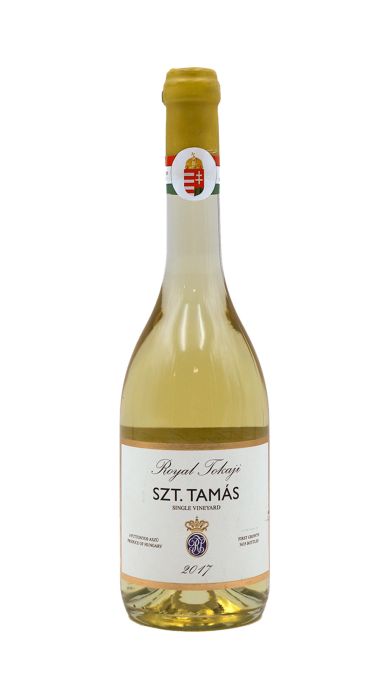Need Help Finding the right wine?
Your personal wine consultant will assist you with buying, managing your collection, investing in wine, entertaining and more.
By continuing, you agree to our privacy policy, consent to cookies, and confirm you are 21 or older.
I have read and agree to the Privacy Policy and Terms of Service.
YOU MUST BE 21 OR OLDER TO CONTINUE
NYC, Long Island and The Hamptons Receive Free Delivery on Orders $300+
Cool Wine Shippers Now Available.
Checkout using your account
Checkout as a new customer
Creating an account has many benefits:

2017 Royal Tokaji Aszu 6 Puttonyos Szt. Tamas
95 VM
Vinous (Galloni) | 95 VM
| Type of Wine | Dessert |
|---|---|
| Varietal |
Proprietary Blend
: Proprietary Blend is a general term used to indicate that a wine is comprised of multiple grape varietals which are either “proprietary” to the winery or is blended and does not meet the required maximum or minimum percentage of a particular varietal. This also is the case for the grape’s place of origin, especially for region, appellation or vineyard designated wines. There are endless examples of blended wines which are labeled as “Proprietary Blend” and in conjunction with each region’s stipulated wine laws and regulations makes for a vast blanket for wines to fall into. Perhaps the simplest example is California; if a wine is to be labeled as Napa Valley Cabernet Sauvignon, it is required to have at least 75% of the varietal (Cabernet Sauvignon) and 85% of the fruit must be cultivated from the Napa Valley wine district. If the wine does not meet the requirements, it is then labeled as Proprietary Blend. |
| Country |
Hungary
: The Hungarian wine industry has literally stood the test of time. Over the course of its very long history of winemaking, Hungary has survived numerous economic, political and religious challenges; from prohibition during Islamic rule in the 16th century, the phylloxera epidemic of the late 1800s, two World Wars and the detriment of a communist regime. Despite its many years of trials and tribulations, Hungary’s resilience has helped etch its name into the history books of fine wine. Hungary has long been recognized for its production of its infamous, sweet, nectar-like, dessert wine, Tokaji, which takes its name from the region of Tokaj in northeastern Hungary. Tokaji has been celebrated throughout history as one of the finest wines in the world. Louis XIV famously described Tokaji Aszu as “the king of wines and the wine of kings.” Tokaji and the eponymous region are so beloved, they are celebrated in the Hungarian national anthem praising the locality and giving thanks to God for it; “...into the vineyards of Tokaj You dripped sweet nectar.” The wine is produced from botrytized grapes (a beneficial fungus that dries and shrivels the grapes), most notably, Furmint and individually hand-picked. The grapes are then mashed and soaked in dry wine or must, resulting in a golden colored, extremely sweet wine which has the potential to age indefinitely. The country’s viticultural accomplishments are not limited to the production of its prized Tokaji, however. The country has 22 official wine regions, each with their own blend of culture, history, terroir and wine style. Its major wine growing regions (in addition to Tokaj) include, Eger, Somlo and Neszmely, Villany, Sopron and Svekszard. Cultivation in Hungary, highly favors white grape varieties with 70 percent of all vineyard space dedicated mainly to the varieties of Bianca, Chardonnay, Cserszegi Fuszeres, Olaszrizling and its beloved Furmint. The remaining 30 percent of vineyard space is devoted to red varieties, mainly Kekfrankos, Cabernet Sauvignon, Merlot, Cabernet Franc and Zweigelt. In total, Hungary has 65,000 hectares under vine, and a wine output of 300 million liters each year. These grapes, mostly native, thrive in the country’s perfectly attuned terroir. As aforementioned, each region is celebrated for possessing its own unique identity, which is greatly due to the precious soils below the vineyards. The diversity of soils throughout Hungary’s many regions vary between sandy, black loam and volcanic to loess-rich loam. The varietals planted in each region perfectly reflect the terroir in which it is cultivated, making the wines incredibly unique. The eastern side of Hungary is wrapped by the Carpathian Mountains, which have a considerable impact on local climate, protecting the land from the cold winds that would otherwise blow in from across Poland and Western Ukraine. The generally continental climate is also moderated by the lakes Balaton and Neusiedl, allowing for a longer, more temperate growing season. As a country with limited financial resources, Hungary has struggled with exportation of wine. Advocates and importers around the world have been working to increase avenues of Hungarian wine outside the country and in recent years numbers have increased. It remains limited, however, especially the elusive Tokaji Aszu, so when bottles become available, they are certain to be acquired quickly. The country continues to adapt and overcome challenges as it has for centuries; a remarkable feat which has allowed the world to enjoy remarkable wines. |
| Region | Tokaj |
| Climat/Vineyard | Szt. Tamas (Single Vineyard) |
| Cru | First Growth |
| Producer | Royal Tokaji |
|---|
Need Help Finding the right wine?
Your personal wine consultant will assist you with buying, managing your collection, investing in wine, entertaining and more.